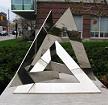 |
THE
FIELDS INSTITUTE FOR RESEARCH IN MATHEMATICAL SCIENCES
|
Physics/Fields Colloquium
2013-2014
|
Organizing
Committee
|
|
Mary
Pugh (Toronto)
|
Stephen
Morris (Toronto)
|
|
 |
|
The goal of the Physics/Fields Colloquium is to feature scientists
whose work is of interest to both the physics and the mathematical
science community. The series has been running since the Spring
of 2007.
Usually there is one speaker per semester. Each speaker gives a
primary, general talk in the regular physics colloquium venue and,
whenever possible, a second, more specialised talk at the Fields
Institute.
Index of 2011-12 seminars
No colloquium talks were planned for the 2012-13 academic year.
| 2013-14
Schedule |
|
March 27, 2014
4:10pm, MP102
|
Scott Franklin
Tangled Granular Matter
A jumble of clothes hangers is a nightmare to untangle, as the individual
hangers hook onto and become entangled with one another. Entanglement-driven
cohesion is a general phenomenon, occurring in many different systems
involving irregularly shaped particles. I'll present a variety of
studies on "geometrically cohesive" materials, defined by
the ability to cohere due to the particle shape. These include long,
thin rods, which can be surprisingly rigid, and U-shaped staples that
resist being pulled apart. The statistical theories that explain how
these piles melt and disentangle are reassuringly simple and capture
the fundamental mechanism of entanglement and "weakest link"
behavior.
NOTE: Special Refreshments will be served in the Physics Lounge (MP110)
at 3:45p.m.
|
|
October 17, 2013
4:10pm, MP102
|
Sharon C. Glotzer, Chemical Engineering at the University of
Michigan
Packing & Assembling Polyhedra
The packing of shapes has interested humankind for millenia. From
the packing of cannonballs on ships to charcoal briquets in bags,
finding how to fit the most number of objects into a space has been
a longstanding problem that has puzzled such great minds as Aristotle,
Kepler, Hilbert and others. Over the past decade, scientists have
discovered ways to synthesize nanoscale building blocks of matter
larger than individual atoms or molecules, but smaller than a red
blood cell, and in a wide variety of materials and shapes, including
polyhedral shapes. The assembly of these building blocks into complex
structures with novel properties remains one of the foremost challenges
in nanotechnology, and involves understanding the role of shape, entropy,
and packing. In this talk we present new insights on packing and assembly,
and present surprising findings from computer simulations predicting
a rich diversity and complexity of structures possible with polyhedra.
|
back to top
|
 |
